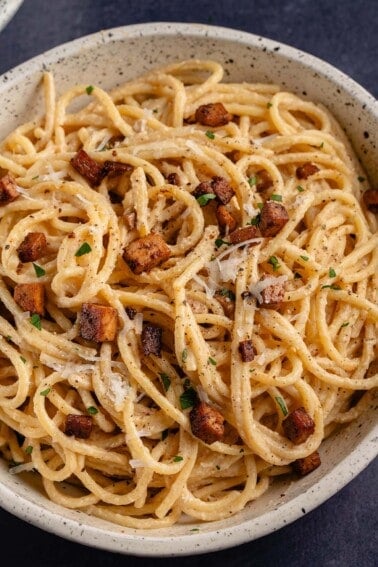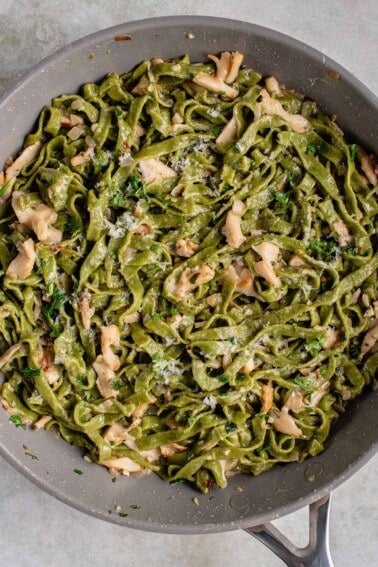This post may contain affiliate links. Please read our disclosure policy.
In the spirit of Earth Month, Chris and I decided that we would challenge ourselves to make changes in our lives to waste less. One thing that we were especially seeking to improve was our food waste. We started doing research on how we could most efficiently incorporate changes into our lifestyle and we realized that by making simple improvements on how we stored our produce, we could prolong the life of our food and waste so much less.
Today we are sharing with you the changes that we have found to be most effective plus our top tips to storing your produce.
We learned that 60 million metric tons of food is wasted in the United States each year, which is equivalent to 20 lb. of edible food per person, per month. And on top of that, 1/3 of all the food produced in the world is never consumed. We definitely know that we are only two people and that we cannot help with shifting that statistic and making changes on that large of a scale, but we also can’t let that discourage us from still making a change. A change is a change, and hopefully by sharing this blog post, we can influence more of you to do the same. The power is in our hands and we all have to work together to help improve this statistic and waste less food altogether.
The Crisper Drawers
First and foremost, be sure that your drawers are never more than 3/4 full. Packing produce into the drawers decreases air flow and will cause the produce to rot faster.
Secondly, take advantage of the humidity settings of your drawers. The motto I learned from the Kitchn is “Rot-low, wilt-high”, so as a general rule of thumb, store your produce that will rot in a drawer with a low humidity setting and store your produce that will wilt in a drawer with a high humidity setting. Setting the humidity of your drawers is as easy as sliding that small window in the refrigerator. It varies from fridge to fridge, but ours is right smack in the middle and easy to get to.
And lastly, keep in mind that fruits can give off high levels of ethylene which is a ripening agent that can spoil certain vegetables if they are kept in the same drawer. It’s important to know what fruits and vegetables thrive together.
To sum it up: it’s important to avoid overpacking your drawers, use the humidity settings and to know what produce is sensitive to ethylene and what produce produces ethylene. I know it sounds confusing, but over time it will get easier and make much more sense! Once you get these three things down, you will make a huge change in the shelf life of your produce and help decrease your food waste.
So let’s get into some details…
High-Humidity Drawer
This drawer is for produce that is sensitive to ethylene gas and that is sensitive to moisture loss. Setting the drawer to high-humidity closes the window and locks in moisture, which will help the produce stay crisper and fresher longer.
Here is a list of produce to keep in the high-humidity drawer courtesy of The Kitchn:
- Belgian endive
- Broccoli
- Brussels sprouts
- Cabbage
- Carrots
- Cauliflower
- Cucumbers
- Eggplant
- Green beans
- Herbs (cilantro, dill, parsley, thyme)
- Leafy greens (kale, lettuces, spinach, Swiss chard, watercress)
- Okra
- Peas
- Peppers
- Strawberries
- Summer squash
- Watermelon
Low-Humidity Drawer
This drawer is for produce that emits ethylene gas and that is not sensitive to moisture loss. This setting opens up the window on the drawer gives ethylene gas and moisture a chance to escape.
Here is a list of produce to keep in the low-humidity drawer courtesy of The Kitchn:
- Apples
- Avocados
- Cantaloupes
- Figs
- Honeydew melons
- Kiwis
- Mangoes
- Papayas
- Pears
- Plantains
- Stone fruit (apricots, nectarines, peaches, plums)
Keep in mind that some fruits do best outside of the refrigerator. These include bananas, mangoes, papaya, persimmons, pineapple, plantains, pomegranates and stone fruit (peaches, nectarines, etc.). Apples can also last out of the fridge if it is less than a week.
Keep Track of What You Have
This may seem obvious, but I can’t tell you how many times Chris and I have forgotten what we had and either purchased a duplicate ingredient or let something go to waste in the refrigerator by not getting to it soon enough. We sometimes go to the market when we are already out, so we don’t have time to double check these things and go by our memory.
Something that we are doing now is keeping track of everything that we have in the refrigerator. This could be as simple as keeping a notepad somewhere where you will see it or even keeping a digital note on your phone. We prefer having it on our phone because that way we could travel with the list and have easy access to it when we are out and about.
Our new Samsung fridge actually has their Family Hub, aka is a “smart fridge”, and it has the capability of helping us create shopping lists, keep track of our items with their expiration dates, PLUS have a digital view of our refrigerator at all times. This has helped us so much because along with our list, we can always log on to the app and get a real life view of our refrigerator to be sure that we are not over or under buying and ingredient.
These are only a few of the dope features of this refrigerator and if you want to learn more, check out our previous fridge tour post and also check Samsung out here.
Store Your Produce Properly
Avocados: It is ideal to store avocados unripe on the counter. If you would like to speed up the ripening process, you can place them into a paper bag with an apple. Trust me, it works! Once avocados ripen, it is helpful to transfer them to the refrigerator to halt the ripening process and preserve them in that state until you are ready to eat them. If you buy too many avocados at once (story of my life) and you don’t want them all to get ripe at the same time, you can place a few unripe avocados in the refrigerator to half their ripening and move them to the counter when you are ready to have them ripen. You will know that the avocado is ripe when it is soft and the stem pops off easily.
Apples: We just learned that the ideal storage temperature for apples is is 30 to 35 degrees F. We used to keep apples on the countertop and they would get soft and go bad quickly, but we now refrogerate our apples to prolong their crisp texture and lifespan in general. I prefer room temperature apples (and food) since my teeth are sensitive, so I just remove them from the fridge and allow them to come to room temperature on the counter for a few hours before consuming.
Nuts and Seeds: We try and buy nuts and seeds only when needed. We used to stock up in large quantities at a time, but we realized that they didn’t last long enough for us to get through them and we were wasting both food and money. Try and buy whole nuts and seeds (and raw, when possible). Nuts and seeds that are modfied (chopped, toasted, or ground) go rancid more quickly. It’s also important to store all of your nuts and seeds to airtight containers in the refrigerator. This keeps air out, prevents outside odors from getting in, and keeps them cold and unaffected by fluctuating kitchen temperatures.
Ginger: Ginger was something that we would just throw into our crisper bins, uncovered, and assume that it will last a long time. It does last a while, but there are also changes we can make to make it last longer and preserve its flavor. First off, we store ginger in an airtight bag. Secondly, wipe off the ginger before storing it to remove any excess liquid, especially if the piece is cut.
Plant-based Milk: It’s important to keep plant based milks cold (after opening) because they are temperature sensitive, especially if it is homemade. Avoid storing your plant based milks on the refrigerator door. Since the door is constantly opened and closed, the temperature fluctuates the most. It’s best to keep items that are not so sensitive on the door, like condiments! Instead, store plant-based milk in a cold spot in the body of the refrigerator.
Carrots: If you purchase carrots with the greens on, cut them off before storing so that they don’t continue to draw nutrients out of their roots (the carrots themselves). Secondly, a good way to preserve the freshness and crispness of your carrots is to actually store them in a sealed container covered in water. You can store them whole but we did not have a jar large enough, so we sliced them. Be sure to change the water every 4-5 days.
Celery: Preserving freshness for celery is the same as carrots, store them in a sealed container covered in water. Be sure to change the water every 4-5 days.
Cauliflower and Broccoli: We have found that our cauliflower and broccoli stay fresh and crisp longer when we transfer them into a sealable bag with a towel or paper towel to absorb any excess moisture.
Greens: This is by far my favorite trick! In order to preserve the life of our greens, we first give them a good rinse when we get home and leave them out to dry on a towel on the counter (you can chop and destem them at this point too). Once they have dried and the towel is still slightly damp, we roll them up in the towel and pop them into the fridge like that. That’s it! Unroll the towel and remove the greens as you are ready to eat them. If you purchase greens on a bag or in a plastic container, it’s important to puncture holes in either to allow air to flow through and to prevent the greens from getting soggy and slimy. You can also line the plastic containers with a towel or paper towel to absorb moisture.
Mushrooms: The number one thing that you should not do when purchasing mushrooms is store them in an airtight bag or container. Secondly, do not wash the mushrooms until you are ready to use them to avoid extra moisture. Also, don’t rinse the mushrooms under running water, but rather use a wet paper towel or cloth to wipe the mushrooms clean. If you purchase mushrooms in packaging, you can store them in the original packaging because those cases are generally designed to allow for some air flow. If it is not, just puncture a few holes in the container. If you are purchasing mushrooms in bulk, you can store them in your refrigerator in a paper bag or cloth bag with the top open to allow them to breathe. Just be sure to wash the cloth bag after each use.
Potatoes and Onions: Just remember to never store root vegetables and onions together, as they produce gases that will make each other spoil faster.
Green Onions: Green onions will actually stay fresh if you place them in a cup with water, just as you would flowers. Store the green onions at room temperature and change the water every couple of days.
Cucumber: Cucumbers were one thing that always seemed to get slimy SO fast. The trick to storing cucumbers and getting them to last longer is by first wrap them up tightly in a paper or regular towel and them placing that into a resealable bag that is mostly sealed with a small air hole. If you are storing a lot of cucumbers, it is best to wrap them individually.
Asparagus: Just like the herbs, it is beneficial to store asparagus like a flower and in a cup of water. It was also recommended to loosely wrap the asparagus in plastic but we opted not to and it still works great!
Tomatoes: Store tomatoes on the counter! Refrigerating them actually damages the fruit and causes them to lose flavor fast. The great things is that they continue to develop flavor as they sit.
Citrus: Citrus does not continue ripening on the counter, it actually starts decomposing and drying out. This drying out can actually be slowed down by refrigeration. Citrus tastes best when it is room temperature so we just remove however many we need from the refrigerator and allow it to sit on the counter for a few hours.
Berries: First off, wash your berries* in a vinegar bath. This is done by soaking the berries in 1 cup vinegar plus 5 cups water for 5 minutes, draining them, and then allowing them to dry on a towel. This is beneficial as the vinegar will help destroy any bacterial spores that may have been on the berries and will preserve them longer. To store your berries, transfer them to a towel lined container. Do not shut the container to allow airflow to come through.
*Note that this does not work well for raspberries. It’s actually recommended to not wash raspberries until eating to lengthen their lifespan. For raspberries, refrigeration is key.
Herbs: Treat herbs as you would flowers and store them in a glass of water. Chanve the water every few days to keep them fresh. We store all herbs but basil in the refrigerator. Basil should remain on the counter in indirect sunlight.,
Dates: We prefer to store our dates in an airtight container out of the fridge. We have found that when we refrigerate them and/or store them in a porous container, they get hard and dry out.
We hope that this blog post can help you make some improvements in your produce storage that will decrease food waste in your household like we did in ours! If you have any questions or comments, feel free to leave them below and don’t forget to check out Samsung and their badass refrigerators!
——————————————————————————–
Disclaimer: This post is sponsored by Samsung Home Appliances, but all opinions shared remain our own. This page may contain affiliate links, which simply means that I earn a commission if you purchase through those links, but your price remains the same. Thank you for supporting Sweet Simple Vegan!



























I never store apples, pears, oranges or avocado (unless cut in half) in the fridge. My apples last for a really long time outside the fridge – not sure why they would only last a few days for you outside the fridge (maybe your climate?). I’ve also found stone fruit last longer in the fridge than out of it.
The parsley was in the fridge too.
I heard from someone that if you put a plastic bag over the parsley or other herb they will last longer. I tried, and amazing it worked. I had good parsley for a month. Also I put a rubber band around the glass to close the bag and also changed the water a few times.
Hi hope this finds you! i just discovered your blog and videos . I rate so much. Where did you get your towels??? you seem to have so many lol i want some .
We got most of them at Ikea. Thank you!!
Thank you the great information will try these tips in the next few days enjoy that you like what you are doing for good health thank you again
Do the strawberries have a vinegar taste ? And also can I do this with blueberries as well ? And just any vinegar ?
We have used both white and apple cider vinegar and they both work well! And no, since it is os diluted there is not vinegary taste 🙂
Thanks Jasmine and Chris! Super helpful tips!
You’re welcome, Stephanie!
I love this blog! I definitely learned a lot. I struggle with produce storage frequently. Can I ask where you got those resealable bags? I just signed up for MightyNest, and I’m wondering if those are the same as what they sell. Thanks so much! I appreciate you!
Yes! These are stasher bags, you can find them here: https://amzn.to/2Df2Tav 🙂
I have to buy herbs in those little plastic containers with the stems still on do those go in water to?
Hi Becca! I stick those in water as well, I just use a smaller cup so that it stands up straight. For those, it may be easier if you rubber band them or use a twist tie to keep them together. I just save mine from my greens etc. and use them for those!
Hi Jasmine! Where are your glass mason jars with the white lids from, or the name of the brand? Love them! 🙂
The brand is Ball! Here is our (affiliate) link if you want to check them out in Amazon 🙂 https://amzn.to/2YcLLhc